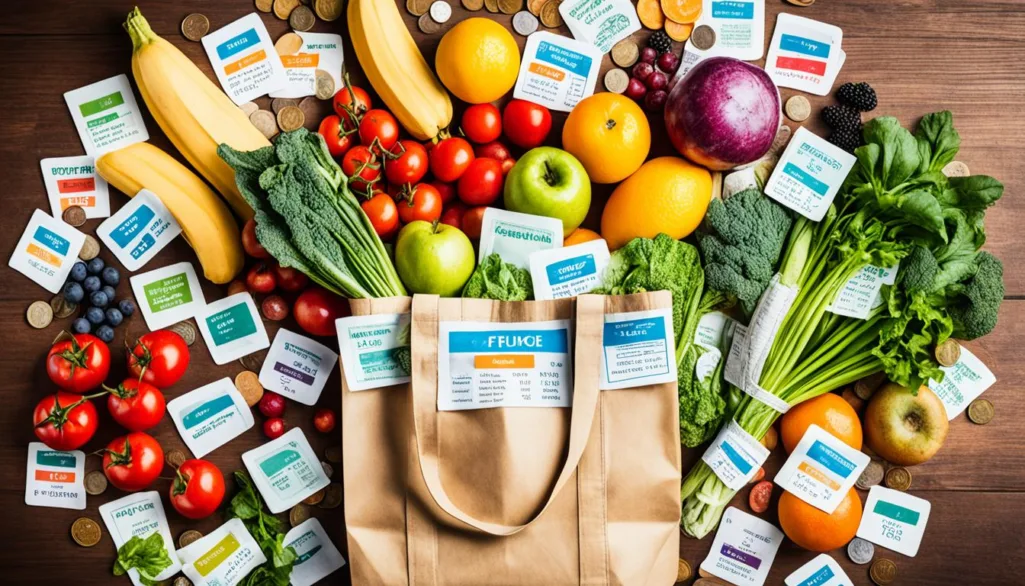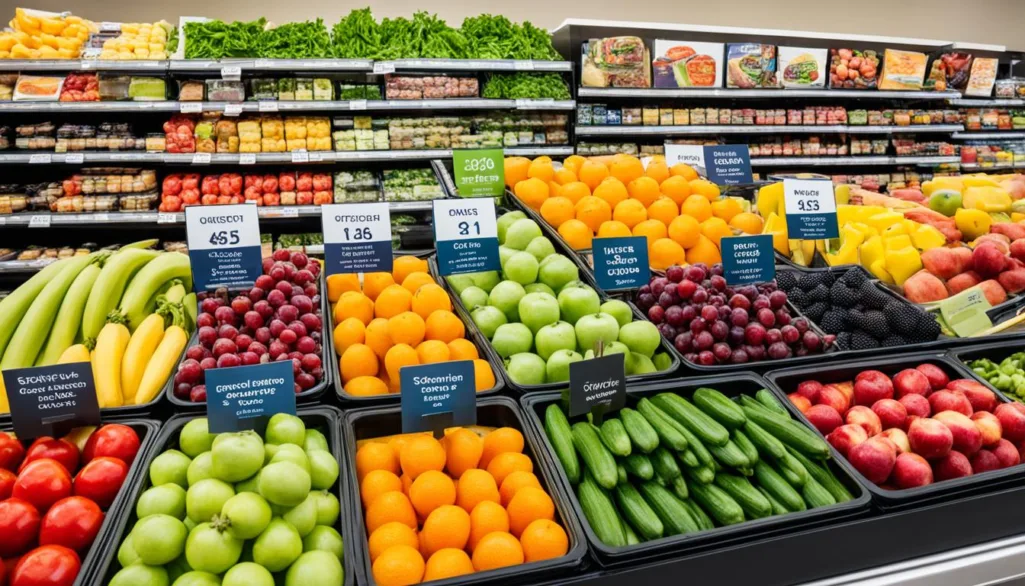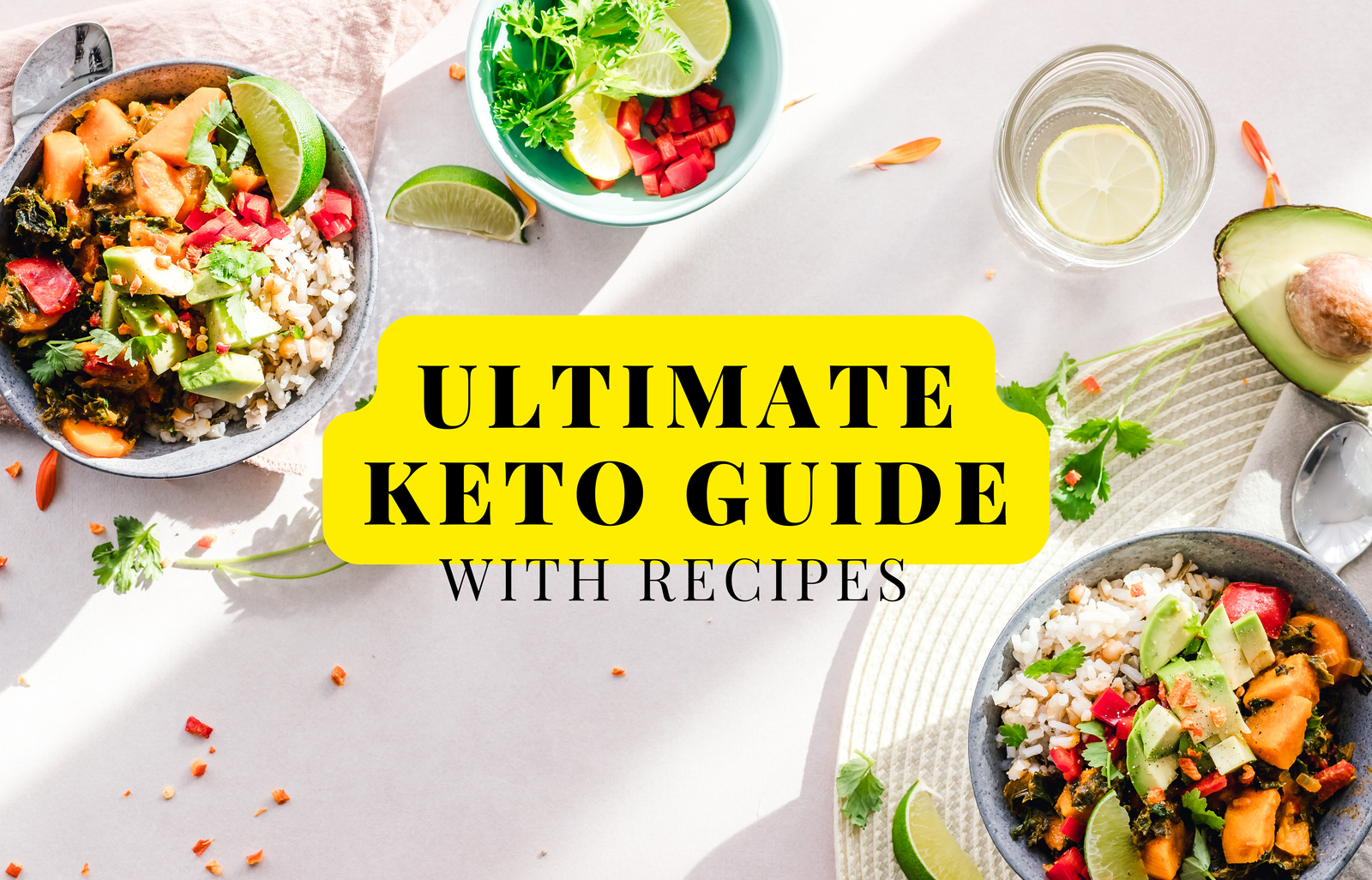Nutrition & Healthy Eating
Healthy Eating on a Budget: Smart Tips & Tricks
Eating healthily on a budget is doable and good for you. With smart planning and strategies, you can have healthy meals without spending a lot. We’ll share tips and tricks for meal planning, shopping, and saving money while eating well.

Key Takeaways:
- Eating healthy on a budget is achievable with the right strategies and planning.
- Meal planning helps you save money and ensures you have nutritious options throughout the week.
- Shopping with a list helps you avoid impulse buys and only purchase what you need.
- Frozen and canned options can be a budget-friendly alternative to fresh produce.
- Coupons and store brands are great ways to cut costs without compromising on quality.
Table of Contents
Plan Your Recipes
Planning your recipes is crucial for eating well while sticking to a budget. This approach allows you to save money and guarantees nutritious meal options.
Create a weekly meal plan that fits your diet and likes. Pick recipes that are both affordable and made with seasonal ingredients. This will save you money and give you the best taste.
Next, think about how you can make your meals last longer. Search for recipes that leave you with leftovers for another meal. You can also tweak recipes to meet your dietary needs by changing ingredients or serving sizes.
It’s smart to rely on versatile ingredients too. For instance, use a whole chicken for several meals. Roast it one night, then use what’s left for sandwiches or salads. This cuts down on waste and maximizes your spending.
For extra convenience, use online tools and apps. They can organize your recipes and make shopping lists. Some even suggest budget-friendly meals with what you already have.

CLICK HERE to get your custom budget friendly Keto plan?
Using Meal Prep to Maximize Your Budget
Meal prepping is a smart move for budget eating. Setting aside time each week to prepare meals saves time, and money, and cuts down on waste.
Begin by cooking large amounts of basics like grains, proteins, and veggies. You can use them in multiple dishes. Cook a big pot of quinoa or rice to add to salads, stir-fries, or bowls.
Then, divide your meals into portions using containers or bags. These are perfect for quick meals or when cooking feels like a chore. It also helps with eating the right amounts and avoiding fast food.
Make sure to label your prepped meals with names and dates to keep track.
With some planning and meal prep, eating well on a budget is doable. You don’t have to trade off taste or nutrition. Just a little organization and creativity can lead to tasty, affordable meals all week.
Shop With a List
Shopping with a list is a smart way to save money and stick to your budget. Plan your meals and make a list. This approach ensures you buy only what you need, avoiding unnecessary items. It not only keeps you financially on track but also saves time by cutting down on extra trips.
To create your list, add all ingredients for meals and snacks. This keeps you from buying things you don’t need. It helps you stick to a budget while focusing on nutrition. Here are tips to make your grocery budget go further:
1. Take inventory of what you already have:
Check your pantry, fridge, and freezer before shopping. This helps avoid buying things you already have. It’s a smart way to reduce waste and save more.
2. Plan for multiple meals:
Try making meals with overlapping ingredients. Buying in bulk saves money and cuts waste. For instance, use some veggies in a stir-fry and then in a salad or roasted dish.
3. Look for sales and discounts:
Focus on items that are on sale or discounted. Use store apps and compare prices to find the best deals. Stick to nutrient-rich foods on sale for a balanced, budget-friendly diet.
4. Consider seasonal produce:
Seasonal fruits and veggies are usually cheaper and fresher. Buying local, in-season produce saves money and tastes better. You can freeze extra for later, too.

Buy Frozen or Canned
Frozen and canned foods are good for eating healthy on a budget. They cost less than fresh ones and stay good for longer. This means you can buy a lot and save money. Frozen and canned fruits and veggies give you important vitamins and minerals. Just watch out for extra sugar or salt, and always read the labels.
Choose frozen fruits and veggies that don’t have extra sauces or flavors. That way, you can keep your meals simple and healthy. For canned foods, go for those in water, not syrup. It’s a smart way to eat well without spending a lot.
| Frozen Options | Canned Options |
|---|---|
| Frozen berries | Canned vegetables |
| Frozen spinach | Canned tomatoes |
| Frozen broccoli | Canned beans |
| Frozen peas | Canned tuna or salmon |
| Frozen mixed vegetables | Canned fruit in water |
Adding frozen and canned options to your meals helps you eat various fruits and veggies on a budget. Try new recipes and mix these items into your meals in fun ways.
Cut Cost With Coupons
Looking for ways to eat well without spending too much? Use coupons to save money and keep eating healthy. It’s all about finding the right deals online or in stores for things you already buy.
Even a little savings adds up and helps you stay on budget. When you use coupons, check the nutrition facts and ingredients to make good choices. Go for store brands too. They can be cheaper but just as nutritious.
Use coupons smartly and pick store brands. This way, you can afford healthy food without spending a lot. Plan meals based on what you have coupons for. Wait for sales to save even more.
| Benefits of Using Coupons: |
|---|
| Savings: Coupons cut down your grocery costs significantly. |
| Quality: You can choose nutritious options for less by comparing products. |
| Flexibility: Coupons let you try different foods while saving money. |
| Meal Planning: Use coupons to plan meals and save more. |
Online Coupon Sources:
- Manufacturer Websites: Get printable or digital coupons from favorite brands.
- Grocery Store Apps: These apps have exclusive deals and discounts.
- Coupon Websites: Find offers from different brands and stores here.
- Email Newsletters: Get coupons by subscribing to store newsletters.
In-Store Coupon Strategies:
- Check Store Circulars: Look for coupons and deals in flyers.
- Customer Loyalty Programs: Join for discounts and rewards.
- Ask At the Checkout: Sometimes, employees know about unadvertised coupons.
- Collect Coupons From Receipts: Check your receipts for added coupons.

Search online sites like brand pages and coupon sites for good deals. Use in-store tactics, such as loyalty programs and checking circulars, to save more.
Try Growing a Garden
Growing your fruits, vegetables, and herbs can be a smart move. You don’t need a big yard; many plants can grow in pots. This way, you always have fresh, healthy food right at home.
Gardening helps you eat well without spending a lot. You can grow tasty tomatoes, crunchy lettuce, and fresh herbs. You control what goes into your food, keeping it clean from bad stuff. It’s a great way to eat healthy while watching your budget.
Starting a garden is not as tough as it may seem. Pick seeds of plants you like. Learn what they need to grow—like sunlight and water. Remember, each plant is different. Even if mistakes happen, keep going. Gardening is about learning and improving.
Here’s a list of plants that do well in small spaces:
- Tomatoes
- Lettuce
- Radishes
- Peppers
- Herbs (such as basil, mint, and parsley)
Having your garden offers joy as you see your plants grow. It connects you to nature and has soothing effects. The money saved can go to other needs or new recipes to try.
Cook at Home
Cooking at home changes the game when you’re eating healthy on a budget. It lets you pick what goes into your food, making it cheaper than eating out. You can save and eat better by cooking for yourself and your family.
Cooking at home allows you to:
- Choose fresh and nutritious ingredients
- Control portion sizes
- Reduce or eliminate unnecessary additives and preservatives
- Create a customized menu that suits your dietary needs and preferences
But why does cooking at home help you save? Here’s the simple breakdown:
- Save on restaurant markup: Eating out adds extra costs to the restaurant’s expenses and profits. Cooking at home cuts these costs, saving you money.
- Utilize leftovers: Making extra and using leftovers is smart. It stretches your meals and budget. Leftovers can become tasty new dishes.
- Embrace meal planning: Planning meals helps you shop smarter. You buy only what you need, reducing waste and avoiding impulse buys.
Cooking at home doesn’t mean you’re stuck in the kitchen all day. Quick meal prep and easy recipes make cooking simple. You won’t have to spend much time or money.
Here’s a budget-friendly recipe to get you started:
- Quinoa Black Bean Salad:
| Ingredients: | Instructions: |
|---|---|
| 1 cup cooked quinoa 1 can black beans, rinsed and drained 1 cup cherry tomatoes, halved 1 cucumber, diced 1/4 cup red onion, finely chopped 2 tablespoons fresh cilantro, chopped 1 tablespoon olive oil 1 tablespoon lime juice Salt and pepper to taste | In a large bowl, mix cooked quinoa, black beans, tomatoes, cucumber, onion, and cilantro. Whisk olive oil, lime juice, salt, and pepper in another bowl. Combine the dressing with the quinoa mix. Stir well. Chill in the fridge for 30 minutes. This blends the flavors. Eat as a main dish or a side. It’s delicious! |
This simple salad is tasty and healthy. It also doesn’t cost much. Feel free to add any veggies or spices you like.
Next, we’ll share tips to avoid impulse shopping. This makes grocery shopping smarter and your nutrition budget-friendly.
Don’t Shop When You’re Hungry
A key tip for healthy eating and saving money is not to shop when hungry. Shopping on an empty stomach often leads to buying impulsively and choosing unhealthy items. This can affect both your wallet and your health. So, eat a snack or meal before going to the grocery store.
By shopping with a full stomach, you make better choices and stay on budget. Hunger makes everything look appealing, especially costly treats that don’t fit your health goals. Eating before shopping helps you focus, avoid impulsive buys, and choose wisely.
Eating first also stops you from spending more than needed and keeps nutritious options a priority. Being hungry makes it tempting to pick fast, less nutritious foods. Fueling up before shopping means you’re more likely to pick foods good for your health and wallet.
So, always eat before a grocery store trip. Satisfying your hunger beforehand changes how you shop, spend, and stick to a healthy, budget-friendly diet.
Another tip for eating well on a budget is to track your spending as you shop. Being aware of your spending helps you keep to your budget and choose wisely in the store.
| Benefits of Tracking Your Budget | Tips to Track Your Budget |
|---|---|
| Prevents overspending | Create a budget before heading to the store |
| Keeps you accountable | Use mobile apps or budgeting tools |
| Identifies areas for improvement | Keep a written record of your expenses |
| Allows for adjustments and savings | Compare prices and consider alternatives |
Buy Store Brands
Choosing store brands can save you lots of money without sacrificing quality. These items are often cheaper than big-name brands. You can enjoy tasty and healthy meals by choosing store-brand canned goods, oils, and frozen fruits and veggies.
Store brands are a good deal compared to pricier options. They’re usually made by the same companies as the big names and are just as good. By picking store brands, you don’t pay extra for the brand name. This saves money for other important things on your grocery list.
Looking for cheap but healthy recipes? Store brands have got you covered. From ingredients for a warm soup to a fresh stir-fry, they offer variety. Try them out to discover new tastes and textures that will make your meals exciting.
Check out the store brand section next time you’re shopping. There, you’ll find many products that fit your budget and healthy eating goals. Using store brands can help you make affordable, tasty, and healthy meals for your family. And it keeps your wallet happy too.
Smart choices are key to eating well on a budget. Store brands help you maintain a healthy and affordable diet. So, if you’re looking for ways to save without losing quality, check the store brand aisle. It’s full of budget-friendly nutrition options and tasty recipes.
Conclusion
To eat healthy without spending too much, start with a plan. Make a recipe list and a shopping list. This helps you keep within your budget. Look for sales, use coupons, and choose store brands to save money. You can still enjoy good meals without spending a lot.
Try using frozen fruits and veggies, and think about gardening. Both offer cheap, fresh food choices. Cooking meals at home and not buying food when you’re hungry are smart moves. They help you focus on health and save money.
Healthy eating does not have to be expensive. It’s about wise choices and better health. With these tips, you can eat well and save money too.
FAQ
Is it possible to eat healthily on a budget?
Yes, you can! With smart planning and strategies, eating well and saving money go hand in hand.
How can I eat well on a budget?
Make a plan before you shop. Stick to your shopping list. Choose frozen or canned fruits and veggies.
Look for sales and use coupons. Think about starting a garden. Cooking more meals at home helps too.
Avoid hunger shopping to keep to your plan. And try store brands – they’re cheaper.
Are frozen and canned options as nutritious as fresh produce?
Yes, they are. Frozen and canned produce is a wallet-friendly pick. It still packs a nutritional punch.
How can I save money on my grocery bill?
Shop with a list to stay on track. Buying in bulk saves money. Look for deals and coupons.
Choosing store brands over name brands can also help you save.
What are the benefits of cooking at home?
Cooking at home lets you manage your meals better. It’s cheaper and healthier. Plus, you control portions.
Why should I avoid shopping while hungry?
Shopping hungry leads to impulse buys. Eat first to make healthier choices. This way, you’ll stick to your budget.
Are store brand items good quality?
Yes, store brands offer great quality for less. Compare their ingredients and nutrition to name brands to see for yourself.
Are there any additional strategies for healthy eating on a budget?
Plan your meals and get creative with recipes. Reuse leftovers wisely. These strategies save money and keep meals interesting.
Is growing your garden cost-effective?
Yes. Growing your produce saves money. You don’t need a big yard to start. Just a little space works.
Can I still enjoy nutritious meals without breaking the bank?
Definitely. Plan your dishes and shop wisely. Use affordable options wisely. Healthy, budget-friendly meals are possible.



